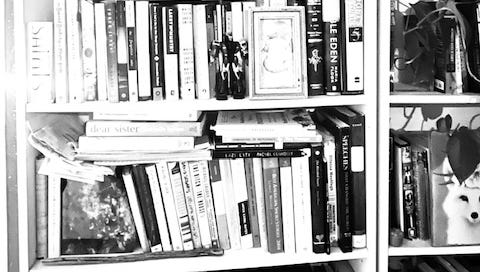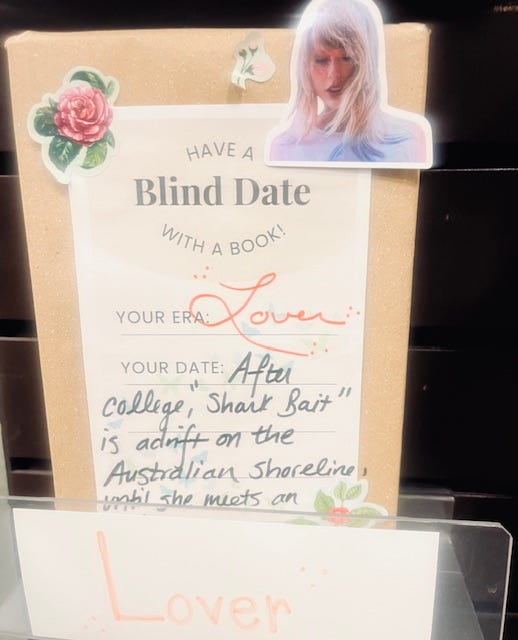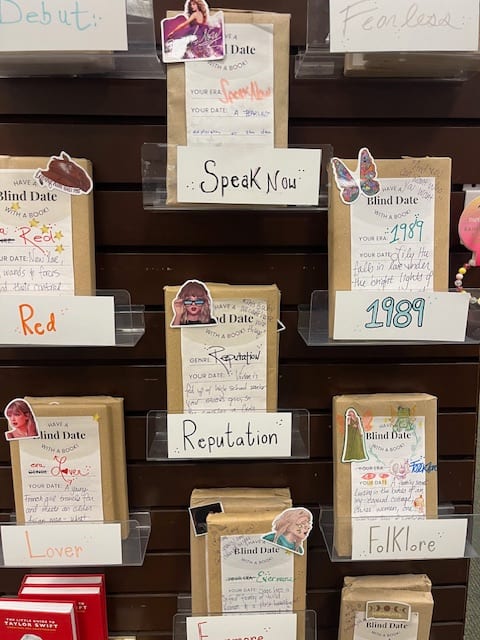my kitchen bookshelves
I’ve been at Barnes and Noble a year now, and what stands out to me most about working in a bookstore ( outside of how much I love it ) is how much power bookstores have over a book’s sales. Not only do the bookstore’s policies influence sales of a particular book, but individual stores/managers, and individual booksellers.
Face-outs, for instance.
Whether a book is spined or face-out is so important to overall sales that it startled me deeply as a writer to find that it is us- the booksellers- who largely decide what is faced out and what is not. This is not true of our ‘new hardback’ section, where 80 percent of the books are face-out, but in paperback, whether a book is cover revealed or not depends entirely on two things: the bookseller handling the books, and the amount of copies of a particular book. Every day, books are shelved, and in that shelving, books necessarily get moved. It is possible for a book with three or four copies to be spined when there simply isn’t enough room for a more space grabbing face-out, but it’s much less likely. The ‘rules’ state that any book with three or more copies should be faced out. This means of course, that the more popular a book is expected to be, the more copies will be delivered to a bookstore, the more likely that book will be face-out.
Booksellers face out books for various reasons. I’ve faced out books because they made sense seasonally, because the authors are friends or peers of mine ( recently faced out Jordan Rosenfeld’s How To Write a Page Turner , Rene Denfield’s Sleeping Giants, and made a Taylor Swift Blind Date book out of Madeleine Lucas’ Thirst For Salt for the Lover era) because the topic was timely, because it’s a favorite book of mine, or simply because I thought the book deserved more eyeballs on it. Sometimes when pulling a book and turning it’s cover outward, I feel MAD WITH POWER. This is something ONLY writers would understand, and it makes me laugh. No one else on the planet would think a lowly bookseller could feel mad with power about anything related to work, but there I am, triumphantly clocking the book’s cover every time I walk past. Someone comes to cashwrap to actually purchase said book? FORGET ABOUT IT. MAD WITH POWER.
We Order Books, Duh
Major booksellers have a designated book buyer whose entire job is to clock what books need to be ordered or should be ordered, but booksellers can also order books, in what’s called shortlisting. It’s not guaranteed that the books we request will be ordered- if the buyer doesn’t think it makes any sense- but it’s likely. I’ve ordered books for events, for endcaps, because I thought the book would be great for our demographic, or because it was simply a book I thought would sell or fill a gap of subject or approach in our inventory. If the book is sold within two months ( I just gestimated that ) of it being shelved, the chances of the book buyer reordering it are good.
Speaking of Endcaps
Endcaps are the book displays on the end of the bookshelves, which are, at B&N, always themed. I’ve made two that have been going for months and selling very well- one for books on Palestine and Israel, and one for Taylor Swift blind date books, which is where I wrap a book, write a description of it and add a Swift sticker and flower stickers ( the sticker album owner of me at 8 years old is so happy ) to the cover, and then place it in the Era of choice; the Era’s are each of Taylor’s albums. I choose the books to match the vibe and the lyrics of the album in that Era. The Swift endcap has been up for an entire year, which blows my mind, and part of the reason I know how well it sells is because there are certain books I reorder over and over for each Era, so I can see how many of that particular book has sold in any time frame I like. For example, I use The Lover by Margurite Duras as a staple for Taylor’s Lover Era, and we’ve ordered those in sets of six over and over again since I started. Or High Fidelity by Nick Hornby for Taylor’s Midnights, or Last Night at the Telegraph Club by Malinda Lo for the 1989 Era. Etc.
If a book is picked for an endcap it is guaranteed a face-out, with the exception of Blind Date books. And if the books on the endcap sell, it will stay up, increasing sales that way, as well.
Shelf-Talkers
One of my favorite part of this job is writing a few sentences about a book in a thick black ink, turning the book face-out, and sliding this paper into the plastic holder underneath the book. This is called a shelf-talker, and it’s a powerful selling tool. For one, it simply makes a book more visible. You see the paper, and you immediately glance at the book cover. And if the shelf-talker is one of two things- or both- all the more likely it will sell the book. One, if the bookseller personally loves this book and puts that passion into the description, what better way to sell a book than a personal shout-out? Two, if the description manages to grab onto one or two things about that book that would in particular make someone interested- for example, “ This is the book that famous singer Candy Cane was reading when she died on a shark floatie in the Pacific Ocean. Only her hand holding the book was found on the floatie. “







l don't know if you've ever listened to The Publishing Rodeo podcast but they had an entire episode last year devoted to how important bookstores and book sellers are to the numbers a book sells. I'd had no idea until then (there's so much info that should be included in MFA programs about the business end of publishing that isn't, at least in my experience), and l find this information fascinating and important. Thanks for writing about it!
I want to read what Candy Cane was reading…